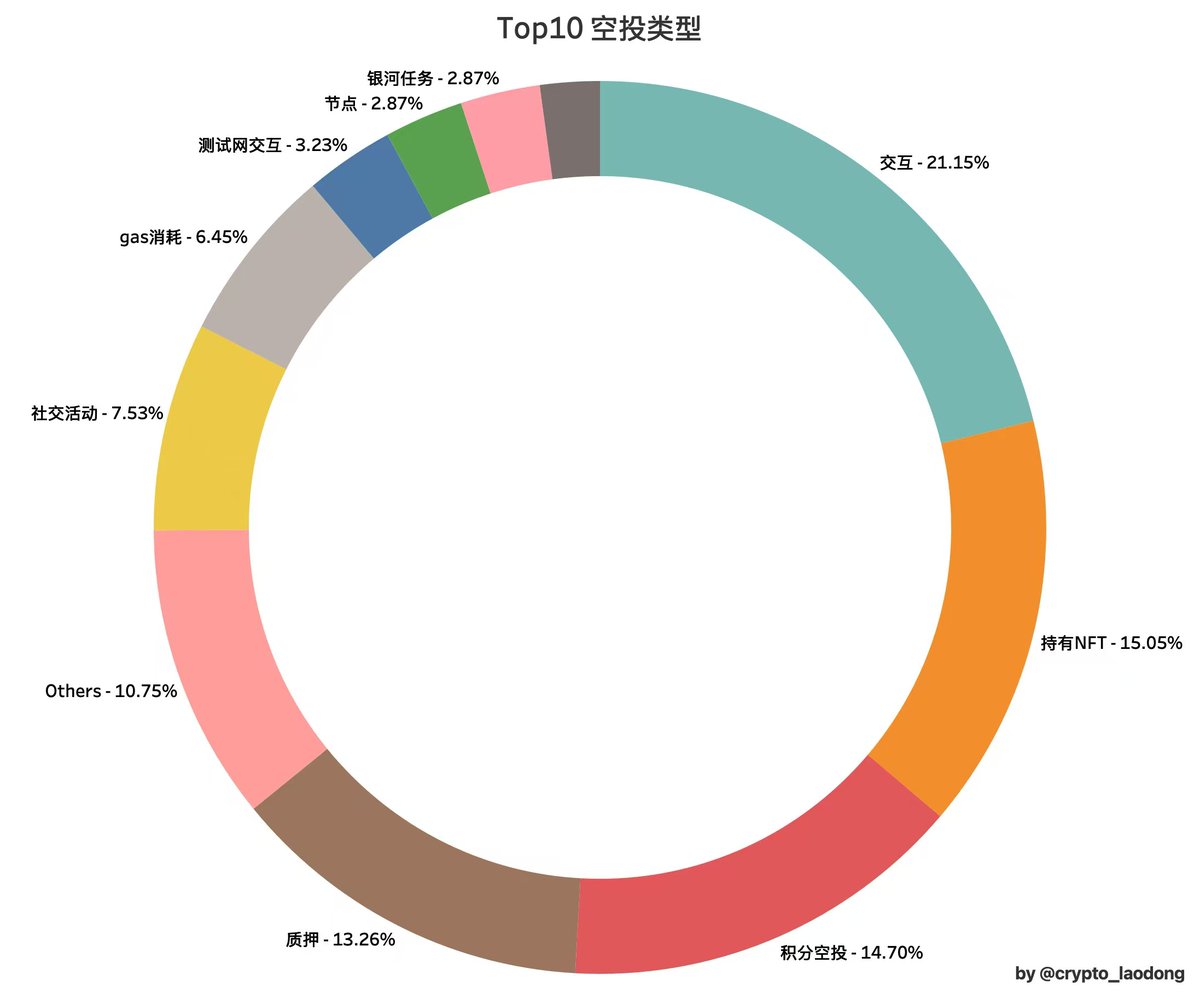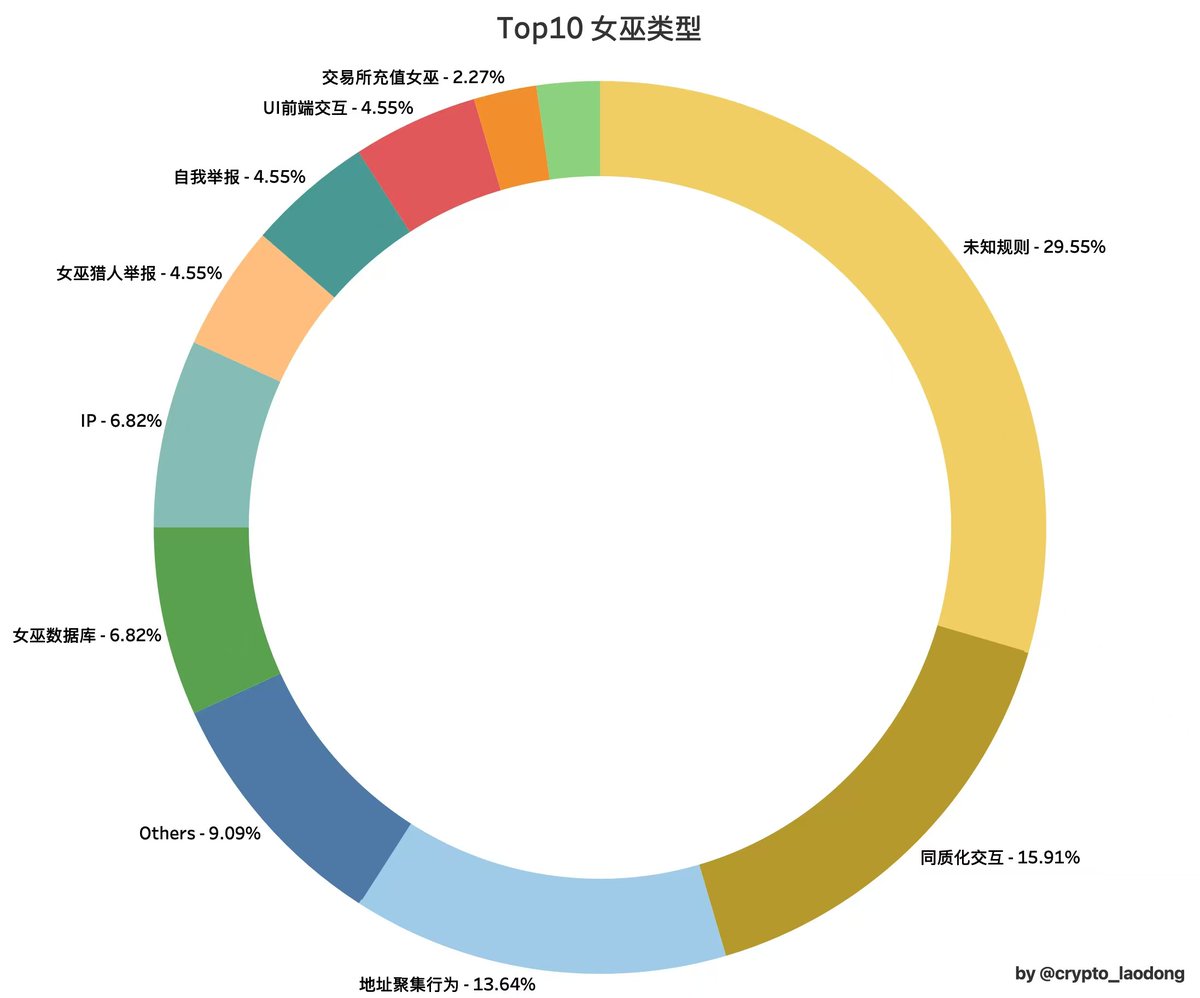Revealing the latest trends and rules of airdrops, who is harvesting? Who is being harvested?
Author: 0x Lao Dong
2024 airdrop data table:
https://docs.google.com/spreadsheets/d/10l-dsjtrFiFAPBGmUNqwVZSviJ4O0lRypEd4Oc9tCZU/edit? gid=0#gid=0
preface
The current airdrop market has entered a naked competition for interests. While the project party acquiesced in data fraud to attract financing, it also carried out large-scale cleanups before airdrops; the Maoist party was fighting hard in the dilemma of not necessarily getting rid of it and not getting rid of it. This game without referees exposed the most acute contradiction in the airdrop market: the tearing of data bubble and real value, and the opposition between short-term interests and long-term ecology.
Lao Dong used airdrop data from 100 projects over the past 24 years to reveal the latest trends and rules of airdrops. Who is harvesting? Who is being harvested?
Conflict of goals between one project party💡
Core contradiction: Data growth demand (creating bubbles) versus controlling token outflows (eliminating bubbles)
“We know that more than 80% of the addresses are studios, but we must rely on them to complete the ecological cold start.& rdquo;
——CTO of a certain L2 protocol
The project party faced a dilemma before TGE:
-
Create foam with your left hand: acquiesce in batch purchases by studios, and the data boom in the manufacturing chain (TVL/transaction volume/number of users) to attract financing;
-
Clear foam with right hand: Address filtering before airdrop and large-scale cleaning;
-
Airdrop type data analysis
Lao Dong compiled the airdrop rules for 100 projects in 2024 and sorted out the proportion of various airdrop types:

Based on project data analysis,Interaction,NFTHolding and point airdrop constitute the three major mainstream mechanisms in the current market。
-
Interactive airdrop: The most important airdrop method is mainly concentrated on the test network and the main network. The project party uses a series of tasks, such as Odyssey activities, to improve on-chain interaction data and TVL to attract financing. However, too much interaction will cause the project party to clean the address. For example, 803,000 addresses of LayerZero were determined as witches, 40% of Linea’s addresses were determined as witches, and StarkNet’s high-frequency interactive users were marked as robots;
-
NFTHold-type airdrop: Secondly, NFT, OAT, etc. are often used as airdrop vouchers, most of which require constant tasks to obtain, or spend money to mint in the form of white lists. Such NFTs are usually negotiable on the chain, which also creates a potential risk of rat warehouses, which is difficult to identify, and has centralized and controllable chips (such as FUEL and Berachain’s NFTs, where the airdrop allocation ratio is unreasonable);
-
Points airdrop: At present, the mainstream method is different from tokens. Points are centralized data that can be tampered with and opaque. At the same time, they can be issued indefinitely and rules can be adjusted at will, making the fairness of airdrops questionable. For example, ME (Points at the witch’s address are directly cleared, and the redemption ratio is also different.) For example, linea (LXP belongs to SBT, which is another form of points. Tokens may not be airdropped in the end) Points airdrop also has serious suspicion of being a rat warehouse (EigenLayer’s snapshot incident, Blast’s additional points, and the controversy over IO’s“ point shrinkage and point theft” all have possible suspicion of being a rat warehouse);
Other airdrop types such as pledge, developer reward, voting, etc. are also different ways for project parties to screen airdrop targets. However, the opacity of the rules, rat holes, inside information, etc. make the fairness of airdrops questionable.
-
Market game and project party’s strategic choice
The current market is a stock game with a limited number of cakes. It is impossible to achieve both needs and needs. The project party cannot satisfy the interests of itself, VC, users and exchanges at the same time. It must allocate benefits and deprive value in a dynamic game. Faced with the contradiction of airdrop incentives, project parties usually adopt two typical strategies:
-
Sunlight type: Suitable for small projects or projects with sufficient rewards, such as HYPT. There is basically no screening and rewards are available at every address. This type of event is generally blind, with no clear airdrop rules, and odds cannot be determined, making it difficult to attract a large number of studios;
-
Strict screening type: Suitable for large projects, users are usually screened by points, interaction frequency, ranking, witch checking, etc., and the last elimination system is adopted. For example, strategies such as SCR (only available investment slots with more than 200 points), talisman stone (filtering through holding inscriptions and NFT), ZKsync and StarkNet (multiple condition filtering), and Layerzero (witch reporting system) have improved the accuracy of reward distribution., but they also increase the uncertainty of participation, making the Mao Party passive in the rule game;
II. Conflict in the hearts of the participants🤔
Core contradiction: If you don’t rub, there will be no vs if you rub, there will be no
Participants also faced a dilemma:
-
If you don’t rub, you won’t. If you do not participate in the project at all, you will definitely not be able to get airdrop rewards. In order to strive for possible benefits, many users have to actively participate in various tasks and activities and invest a lot of time and resources, thereby further exacerbating market involvements and participants ‘anxiety;
-
You don’t have to be there No matter how much you invest, you may not be able to get rewards. User input is not proportional to output, and the project party uses various means to filter addresses. The complex screening mechanism caused many participants to be disqualified for airdrops due to strategic mistakes or being wrongly judged as witches;
Excessive competition and investment risks
In order to compete for limited rewards, users have to donate a large amount of data and activity, but at the same time, complex opaque rules and strict screening standards make it difficult for participants to predict their actual rewards;
Among the 100 projects in 2024There are 32 people who specifically investigated witches。The screening criteria of most project parties are not public, and the review process is a black box operation, completely in the hands of the project party. Users are like lambs waiting to be slaughtered, being arbitrarily judged. The following figure shows an analysis of the types of witches:

The core basis for the project party to screen witches includes:
-
homogeneous interaction: A large number of similar operating patterns are the main reason for being judged as a witch;
-
address aggregation behavior: Multiple addresses perform similar operations at the same time and in the same environment, making them easy to be identified and cleared;
-
IP, devices, front-end interactions: More and more project parties are analyzing user behavior through front-end data, making it difficult for the confrontation strategy of simply changing IP and equipment to work;
If you want to survive this airdrop game, money and luck alone are not enough. You also need more sophisticated interactive strategies, stronger technical support, higher anti-reconnaissance capabilities, and continuous investment and persistence.
The contradiction between the three project parties and the Lu Mao Party🤝
Core contradiction: one loss, one prosperity, one prosperity
In the game of airdrop incentives, a symbiotic relationship was formed between the project party and the Mao Party, and their destinies were closely linked:“”
-
Co-Prosperity: When both parties reach a relatively balanced incentive mechanism, it can not only attract enough active data, but also ensure ecological quality, and both project parties and users can benefit from it;
-
common loss: If either party is out of balance, whether it is the project party’s improper airdrop strategy or the Maoist party’s excessive brushing, it will eventually have a negative impact on the entire ecology, and it will be difficult for both parties to stay alone.
Dynamic game:
-
When participating in airdrop activities, the project party usually sets a certain threshold. For example, Linea’s POH certification and IP threshold. When the project party formulates a looser participation threshold, the Mao Party can participate in a large number of times, resulting in a situation of a surge in data in the short term. However, once this bubble effect is purged by a strict screening mechanism, the entire ecosystem may fall into a serious disconnect between data and actual user activity. Dilemma. For example, after LayerZero announced that it had completed the snapshot, the number of active addresses on the chain dropped sharply;
-
On the contrary, when designing the rules, the project party raised the threshold for participation to ensure that only users who are truly active and contribute real value can be rewarded. Although such a high threshold prevents the number of participants from exploding in the short term, it allows for a healthy and stable growth of active addresses on the chain and avoids the creation of a data bubble.
The essence of airdrops is a dynamic game of interests between project parties and users. For the Mao Party, if we want to gain profits steadily, we must refine strategies, improve the quality of interactions, and even build long-term value; for the project party, we should not deliberately pursue financing. If we go to a large company, the core task should not be how to create short-term prosperity for PUA users, but how to build a long-term sustainable ecosystem and truly provide value support.
Welcome to join the official social community of Shenchao TechFlow
Telegram subscription group: www.gushiio.com/TechFlowDaily
Official Twitter account: www.gushiio.com/TechFlowPost
Twitter英文账号:https://www.gushiio.com/DeFlow_Intern



